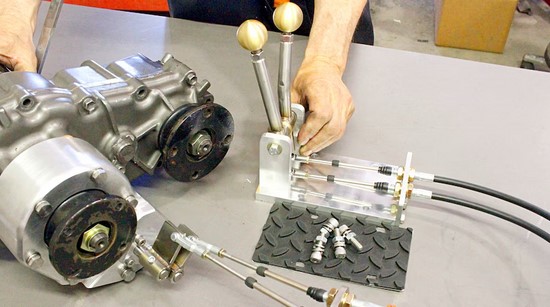 The Suzuki Samurai transfer case is an important component of your vehicle’s drivetrain. It is responsible for transferring power from the engine to the wheels, allowing you to shift between two-wheel drive and four-wheel drive. Over time, the transfer case can wear out or become damaged, requiring a replacement or upgrade. Fortunately, there are a variety of replacement and upgrade options available for the Suzuki Samurai transfer case. This guide will provide an overview of the different types of transfer cases available, as well as the benefits and drawbacks of each option.
The Suzuki Samurai transfer case is an important component of your vehicle’s drivetrain. It is responsible for transferring power from the engine to the wheels, allowing you to shift between two-wheel drive and four-wheel drive. Over time, the transfer case can wear out or become damaged, requiring a replacement or upgrade. Fortunately, there are a variety of replacement and upgrade options available for the Suzuki Samurai transfer case. This guide will provide an overview of the different types of transfer cases available, as well as the benefits and drawbacks of each option.
Exploring the Benefits of Upgrading Your Suzuki Samurai Transfer Case
The Suzuki Samurai is a popular off-road vehicle that has been around since the 1980s. It is known for its ruggedness and reliability, but it is also known for its limited off-road capabilities. One of the main reasons for this is the stock transfer case. The stock transfer case is a two-speed unit that is not designed for extreme off-roading. Upgrading the transfer case can significantly improve the off-road performance of the Suzuki Samurai.
The most common upgrade for the Suzuki Samurai transfer case is to replace it with a four-speed unit. This upgrade provides the driver with more control over the vehicle’s speed and torque. The four-speed transfer case allows the driver to select a low gear for climbing steep hills or navigating difficult terrain. It also allows the driver to select a higher gear for cruising on flat terrain. This increased control over the vehicle’s speed and torque can make a significant difference in the off-road performance of the Suzuki Samurai.
Another benefit of upgrading the transfer case is improved fuel economy. The four-speed transfer case allows the driver to select a lower gear for cruising on flat terrain, which reduces the amount of fuel used. This can result in significant savings over time.
Finally, upgrading the transfer case can also improve the reliability of the Suzuki Samurai. The four-speed transfer case is designed to be more durable than the stock two-speed unit. This increased durability can help to ensure that the vehicle will remain reliable for many years to come.
In conclusion, upgrading the transfer case on the Suzuki Samurai can provide a number of benefits. It can improve the off-road performance of the vehicle, improve fuel economy, and increase the reliability of the vehicle. For these reasons, it is an upgrade that should be seriously considered by any Suzuki Samurai owner.
Understanding the Different Replacement Options for Suzuki Samurai Transfer Cases
The Suzuki Samurai is a popular off-road vehicle that is known for its ruggedness and durability. However, like any vehicle, it is subject to wear and tear over time. One of the most important components of the Samurai is the transfer case, which is responsible for transferring power from the engine to the wheels. When the transfer case fails, it can cause a variety of problems, including reduced performance and increased fuel consumption. Fortunately, there are several replacement options available for Suzuki Samurai transfer cases.
The first option is to replace the transfer case with an OEM (Original Equipment Manufacturer) part. OEM parts are designed to be exact replicas of the original part, and they are typically the most reliable and cost-effective option. However, OEM parts can be difficult to find and may be expensive.
The second option is to purchase a remanufactured transfer case. Remanufactured transfer cases are rebuilt using new or refurbished parts, and they are typically more reliable than aftermarket parts. However, they can be more expensive than OEM parts.
The third option is to purchase an aftermarket transfer case. Aftermarket transfer cases are designed to be compatible with the Samurai, but they may not be as reliable as OEM or remanufactured parts. Additionally, aftermarket parts may not be covered by the vehicle’s warranty.
Finally, the fourth option is to have the transfer case rebuilt. This option is typically the most cost-effective, as it allows the owner to use their existing transfer case and have it rebuilt with new or refurbished parts. However, it is important to note that rebuilt transfer cases may not be as reliable as OEM or remanufactured parts.
In conclusion, there are several replacement options available for Suzuki Samurai transfer cases. OEM parts are the most reliable and cost-effective option, but they can be difficult to find and expensive. Remanufactured transfer cases are more reliable than aftermarket parts, but they can be more expensive. Aftermarket transfer cases are designed to be compatible with the Samurai, but they may not be as reliable as OEM or remanufactured parts. Finally, having the transfer case rebuilt is typically the most cost-effective option, but it may not be as reliable as OEM or remanufactured parts.The Suzuki Samurai Transfer Case is a reliable and durable part of the vehicle, but it can eventually wear out or become damaged. Fortunately, there are a variety of replacement and upgrade options available to keep your Samurai running smoothly. Whether you need a complete replacement or just an upgrade, there are plenty of options to choose from to ensure your Samurai is running at its best.

